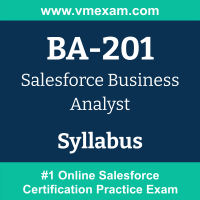 The Salesforce BA-201 exam preparation guide is designed to provide candidates with necessary information about the Business Analyst exam. It includes exam summary, sample questions, practice test, objectives and ways to interpret the exam objectives to enable candidates to assess the types of questions-answers that may be asked during the Salesforce Certified Business Analyst exam.
The Salesforce BA-201 exam preparation guide is designed to provide candidates with necessary information about the Business Analyst exam. It includes exam summary, sample questions, practice test, objectives and ways to interpret the exam objectives to enable candidates to assess the types of questions-answers that may be asked during the Salesforce Certified Business Analyst exam.
It is recommended for all the candidates to refer the BA-201 objectives and sample questions provided in this preparation guide. The Salesforce Business Analyst certification is mainly targeted to the candidates who want to build their career in Salesforce Consultant domain and demonstrate their expertise. We suggest you to use practice exam listed in this cert guide to get used to with exam environment and identify the knowledge areas where you need more work prior to taking the actual Salesforce Business Analyst exam.
Salesforce BA-201 Exam Summary:
|
Exam Name
|
Salesforce Business Analyst |
| Exam Code | BA-201 |
| Exam Price |
Registration fee: USD 200 Retake fee: USD 100 |
| Duration | 105 minutes |
| Number of Questions | 65 |
| Passing Score | 72% |
| Recommended Training / Books |
Prepare for Your Salesforce Business Analyst Credential Cert Prep: Salesforce Business Analyst |
| Schedule Exam |
Kryterion Webassessor PEARSON VUE |
| Sample Questions | Salesforce BA-201 Sample Questions |
| Recommended Practice | Salesforce Certified Business Analyst Practice Test |
Salesforce Business Analyst Syllabus:
| Section | Objectives | Weight |
|---|---|---|
| Customer Discovery |
- Determine business strategies, goals, initiatives, and challenges to define the scope of a Salesforce project or business initiative. - Discover how a customer is leveraging existing products to establish the current state. - Understand and explain Business Analyst roles and responsibilities in different phases of the implementation lifecycle. - Apply the implementation lifecycle for planning business analysis activities. - Analyze the customer's Salesforce environment(s) to identify opportunities and constraints. - Demonstrate knowledge of Salesforce capabilities, align them with business needs, and recommend potential solutions. |
17% |
| Collaboration with Stakeholders |
- Plan discovery activities based on the target stakeholders to perform a thorough analysis of business needs. - Identify key stakeholders and develop relationships with them as a trusted advisor to act as a liaison between business and technical teams. - Given a scenario, choose the most effective technique for eliciting business needs from stakeholders. - Explain how to move from current state analysis to an agreed future state design. - Given a scenario, manage competing priorities to obtain stakeholder consensus. |
23% |
| Business Process Mapping |
- Demonstrate how to define the scope of a complex business process and break it down into manageable steps. - Analyze and document a business process to elicit requirements and engage stakeholders to visualize a future state. - Document business processes in a version controlled repository to manage scope. |
12% |
| Requirements |
- Understand the differences between scope, requirements and user stories. - Engage stakeholders to identify, validate, and prioritize requirements. - Document requirements in a version controlled repository to manage scope. |
18% |
| User Stories |
- Understand the components of a user story to perform thorough analysis. - Demonstrate how to write acceptance criteria that convey the requirements and are ready for development. - Document user stories in a version controlled repository to manage scope. |
18% |
| Development Support and User Acceptance |
- Support and validate project delivery to ensure the solution meets the requirements. - Support and validate user acceptance testing (UAT) to ensure the solution meets the requirements. |
12% |
